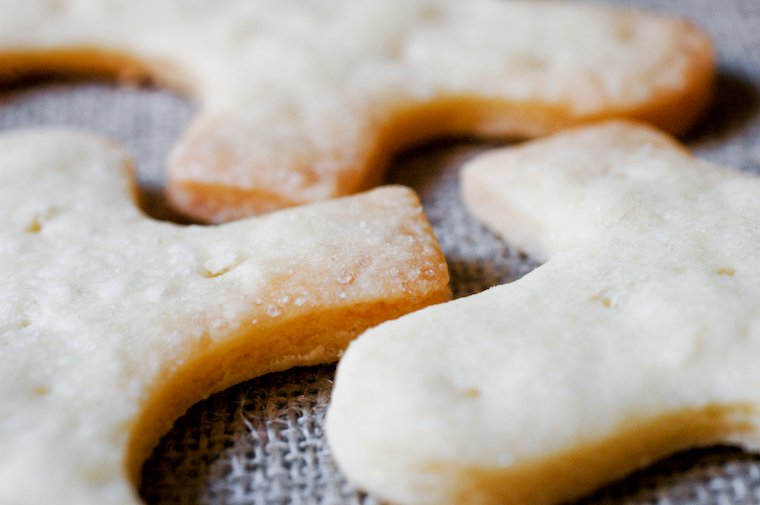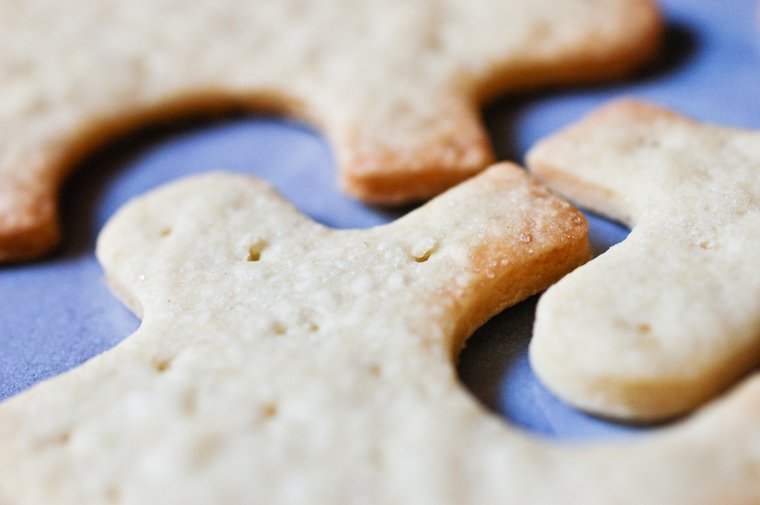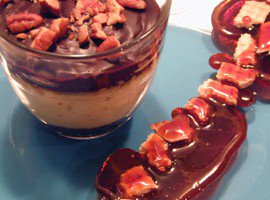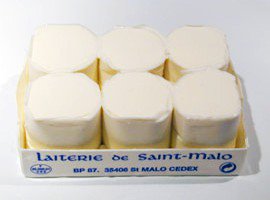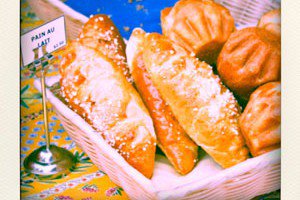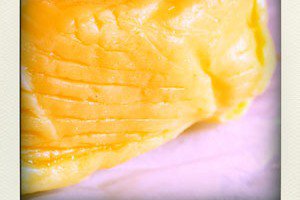A little while ago I told you about the cookbooks my grandmother gave me, old, tattered, and much-loved volumes that used to belong to my great-grandmother before her. One of them is called Mes Recettes pour votre dessert, and it contains 710 recipes for sweet things, arranged in alphabetical order from Amandés de Liège to Visitandines. And on page 222, this precious book offers a recipe for petits beurres.
Le petit beurre is a crisp little thing, not too sweet and not too rich, that melts on your tongue and takes kindly to a brief dunking in a cup of hot chocolate.
Le Petit Beurre (literally “little butter”) is a small rectangular cookie that was invented in 1886 by Louis Lefèvre-Utile, founder of the LU company in Nantes: he was the first to create a cookie manufacture in France, and was very much ahead of his time in terms of marketing and advertisement too.
This cookie, also called Petit LU, quickly became a classic, and although it is now 120 years old it is as sprightly as ever, with millions of packages sold every year throughout the world. The fascinating story of the petit beurre would really warrant a whole book — I wouldn’t be surprised if one had already been written — but you can read a little more about it here (in French). [Note: the LU brand now belongs to the Danone group.]
Le petit beurre is a crisp little thing, not too sweet and not too rich, that melts on your tongue and takes very kindly to a brief dunking in a cup of hot chocolate. Its signature silhouette has scalloped edges, tiny holes on the surface as if pricked by a needle, and a small browned ear at each corner.
Some advocate that the corners are the best, and a close member of my family was once admonished for having gone through a whole package, eating exclusively les petites oreilles, and returning the rest neatly into the paper wrapper. This same family member also had an interesting experience with a tiny chestnut that fit exactly inside her left nostril, but I will keep that story for another time. [Update: The close family member tells me that she calls the corners “thumbs”, not “ears”, because they look like a baby’s toes.]
Because petits beurres are so readily available from French stores — even the tiniest ones — they don’t seem to be the type of cookie that one makes at home, and I had never seen a recipe anywhere before. To my knowledge, the special mold that gives the petit beurre its shape is not for sale, so I chose to make mine with the puzzle cookie cutter that I bought from Muji recently. Whichever shape you pick for yours, make sure it is one that has dents and corners (a star would work well too) so that you get the maximum amount of crisp angles.
The recipe was charming (I’ve copied it below for your enjoyment), very easy to follow, and the resulting cookies were wonderful: although no one would mistake them for the original petits beurres in a blind test, there was a clear similarity of flavor.
Less dry than the packaged version, my petits beurres were crisp and crumbly like good sablés should be, with just the right dose of sweetness, a clean, lingering taste of fresh butter and crème fraîche, and a delightful hint of salt. Perfect for an afternoon snack, they were also much enjoyed with sliced strawberries (especially Mara des Bois from the market) or a rhubarb compote.
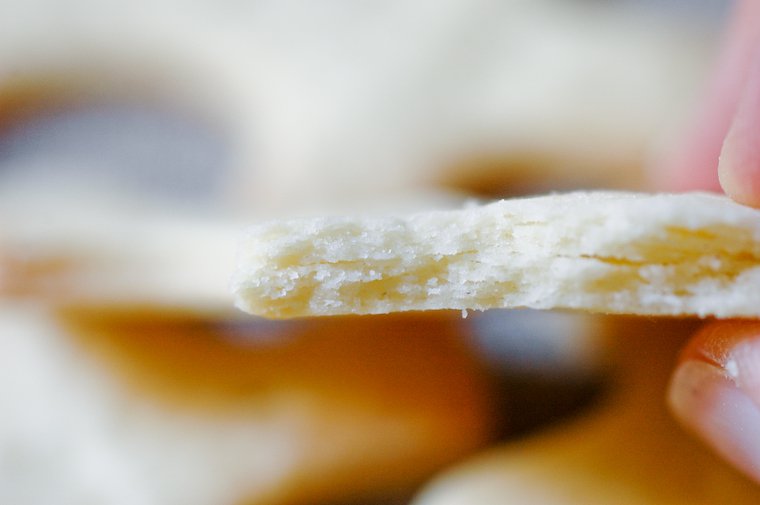

Have you tried this? Share your pics on Instagram!
Please tag your pictures with #cnzrecipes. I'll share my favorites!
This is translated and adapted from the original version, reproduced below.
Ingredients
- 200 grams (1 2/3 cup) all-purpose flour
- 80 grams (6 tablespoons) unsalted butter, diced
- 40 grams (3 tablespoons plus 1 teaspoon) sugar
- 1/2 teaspoon fine sea salt
- 2 to 3 tablespoons crème fraîche or heavy cream
Instructions
- In a medium mixing-bowl, rub together the butter and flour until the mixture resembles coarse meal.
- Form a well in the center, and add the sugar, salt, and 2 tablespoons crème fraîche into the well. Stir with a fork in a circular motion starting from the center until the cream is absorbed, then knead the dough gently until smooth. If the dough is too dry to come together, add a little more cream, one teaspoon at a time, until you reach the desired consistency.
- Divide the dough in two, and gather each half into a slightly flattened ball. Wrap in plastic and chill for an hour.
- Preheat the oven to 180°C (350°F) and grease a baking sheet with butter.
- Working with one ball of dough at a time, roll it out on a lightly floured surface to a thickness of about 1/2 centimeter (1/5 inch). Use a cookie cutter to cut out cookies, and transfer them on the prepared baking sheet. Repeat with the remaining dough.
- Prick the cookies all over with the head of a pin, and slip into the oven to bake for 12 to 15 minutes, keeping a close eye on them, until golden and just slightly browned at the edges.
- Transfer to a rack to cool completely, and keep in a tin box in a dry place, safely away from little mice... (See note).
Notes
The mice note is not to be taken literally: the expression petites souris refers to members of the household, most likely children, who may sneak into the kitchen, filch a cookie or two or three, and accuse the mice when confronted about the mysterious disappearance.

Have you tried this? Share your pics on Instagram!
Please tag your pictures with #cnzrecipes. I'll share my favorites!
This recipe is reprinted from Mes Recettes pour votre dessert by Marmiton, published by Société Anonyme d'Imprimerie et Editions Catholiques du Nord (Lille). Edition and date unknown (the front and back pages and covers are missing) but the book was first published just after World War I. The other book I have in this collection has no date either, but was the 9th edition.
Ingredients
- Farine de gruau, première qualité : deux cents grammes
- Beurre frais : quatre-vingt grammes
- Sucre blanc tamisé : quarante grammes
- Sel : cinq grammes
- Six cuillérées à bouche de crème double
Instructions
- Dans un saladier, travaillez ensemble le beurre et la farine, de façon à obtenir quelque chose comme du pain émietté. Faites un trou dans le milieu, déposez-y le sucre, le sel et la crème et travaillez le tout sans perdre une minute. Votre pâte étant bien lisse, réunissez-la en une boule que vous laisserez reposer au frais pendant une heure dans le saladier qu'il faudra couvrir.
- Alors vous étendrez cette pâte au rouleau, sur votre planche à pâtisserie légèrement farinée, en lui donnant un demi-centimètre d'épaisseur. Avec un emporte-pièce à petits beurres, vous couperez vos gâteaux, vous les poserez sur une plaque beurrée et les piquerez à l'aide d'une aiguille. Faites-les cuire à four modéré jusqu'à ce qu'ils soient de couleur blonde. Laissez refroidir et mettez-les en boîtes de fer-blanc dans un endroit sec, hors de portée des petites souris...
